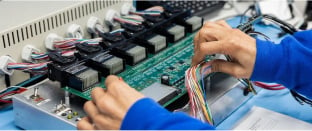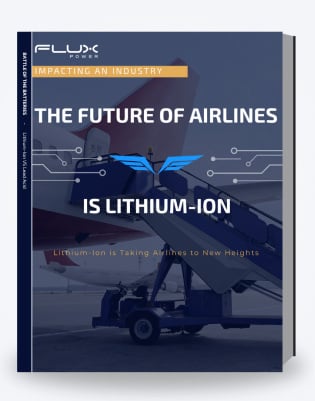Why Are Forklift Accidents on the Rise?
As with any piece of machinery, accidents can happen in a manufacturing setting. It is no different with forklifts. In a given year, 34,900 serious injuries result from forklift accidents, and 61,800 non-serious injuries related to forklifts happen annually.
Forklift accidents have been on the rise across the nation, and 70% of these accidents are preventable with standard safety measures, according to OEA Safeguard "Forklift Accident Statistics."
A couple of factors have contributed to an increase in forklift accidents:
- Labor turnover
- A shift to 24/7 operations
Labor Turnover
The “Great Resignation” is a term coined due to a shift in the labor market from the COVID-19 pandemic. Because of the record number of employees quitting jobs and the struggle for companies to retain employees, this event in time is now being called the "Great Resignation."
With the "Great Resignation," more warehouses struggle to retain, hire, and train new employees. As a result, forklift drivers tend to have less experience and less time for adequate safety training.
Shift to 24/7 operations
The pandemic has placed burdens on the warehousing industry to shift to round-the-clock operations. Employees are working longer hours, and more new employees are being hired, all of which can lead to an increase in human error. For companies trying to keep up with customer demand, throughput is sometimes prioritized over forklift safety and forklift fleet management.
Five Most Common Forklift Accidents
Forklift safety incidents have increased in frequency over the years. But that does not mean that the trend cannot be reversed. There are easy ways to help prevent these types of forklift safety incidents. Many forklift warehouse accidents happen due to human errors and not taking extra precautions.
Here are some examples of significant forklift safety accidents that are most commonly found in warehouses.
- Forklift Rollovers
- Pedestrian Collisions
- Falling Loads
- Mechanical Failure
- Emissions Poisoning
Forklift Rollovers
A forklift rollover is when a forklift of any type tips over. Forklift rollovers are the most common type of forklift accident found in warehouses. A forklift turnover typically happens if the load is overextended or out of balance, shifting the center of gravity of the entire mass (truck + load) to a tipping point.
Forklifts rollovers can also happen with abrupt movements, like sharp turns, turns on inclines, or uneven driving substrate. A forklift turnover accounts for nearly 24% of all forklift accidents.
Forklift turnovers are very hazardous to the driver and others in the vicinity. It can cost companies a lot of money when accidents like forklift rollovers happen. OSHA fines can be $13,500 for serious violations, and damages from forklifts tipping over can estimate at as much as $86M per year from improper equipment handling.
Employers must follow OSHA-created regulations and safety training. Forklift turnovers can be prevented by following OSHA-required speed limits and slowing down when rounding corners. OEM forklifts have different equipment centers of gravity, so operators need to know how much a forklift can handle.
Pedestrian Collisions
A pedestrian collision is when a forklift strikes, bumps into, or rolls over a person (or any part of their body). This type of forklift accident happens from the failure of a forklift driver and pedestrian to see each other clearly and communicate travel intentions or yield right of way. Pedestrian collisions can also occur due to a lack of signaling between the operator and the pedestrian.
Nearly 20% of all forklift accidents involve pedestrians, and 36% of fatal forklift accidents involve pedestrians. Proper safety training could reduce forklift pedestrian accidents. Training will help operators and pedestrians around forklift equipment in the long run.
According to the CDC, productivity loss from injured workers could cost around $225.8B each year.
Many of these accidents are attributed to undertrained employees who do not understand the risks of operating warehouse equipment. Implementing consistent forklift training could help mitigate these risks and ensure operators have a high sense of awareness.
Falling Loads
Falling loads occur when a load slides, tips, or falls off the forks of a forklift so that it can no longer be safely transported. This type of accident usually happens when the load is off-center, loose, or unsecured. Loads may fall due to moving, shifting, or tilting the mast too fast.
Falling loads account for 8% of all forklift-related fatalities but cause some of the most common forklift injuries in the workplace. Even though operators are trying to move as fast as possible to get the job done, it is still essential to use care when lifting any load and ensure the product is centered and secured. Checking on the small details can help significantly reduce and prevent forklift injuries.
Mechanical Failure
Forklift mechanical failure is when a forklift part fails to operate in its intended manner. Mechanical failure is usually a result of improper operation or maintenance. Most of the time, it is an operator mishandling issue, although it can also be a failure from a faulty component.
Creating forklift operator checklists and consistently maintaining warehouse equipment can reduce the chances of mechanical failures happening in operations and the expensive maintenance costs to fix the equipment that comes with it.
Emissions Poisoning
Emissions poisoning occurs when forklift operators suffer health consequences (sometimes severe) due to exposure to toxic fumes or liquids emitted by forklifts. Emission poisoning typically only happens with internal combustion forklifts, although it can also occur from lead acid batteries due to a lack of ventilation, PPE, or prolonged exposure to fumes.
Internal combustion engine forklifts can cause emission poisoning from poor ventilation, incorrect fuel mixture, leaking exhaust, and excessive idling. Operators can reduce these emission poisoning causes by installing carbon monitors and scheduling regular maintenance. When operators do regular maintenance checks, it is important to adjust the fuel mixture and check for leaks to ensure no carbon monoxide gas is building up.
Lead acid batteries emit hazardous fumes when charging. Well-ventilated rooms are essential to control fumes from lead acid batteries and prevent emission poisoning.
On the other hand, lithium-ion battery packs do not emit any hazardous materials, making them safer in indoor workplaces. If companies want to reduce hazards in the workplace, lithium-ion battery packs would be the best choice for emission reduction.
How to Prevent Forklift Accidents & Improve Forklift Safety
Switching to lithium-ion technology can often be the easiest and most cost-effective solution to improving forklift safety. A few benefits of lithium-ion batteries that can help dramatically enhance warehouse safety include:
- More compact - Lithium-ion batteries are more compact, making it easier to navigate tight spaces, allowing for more visibility in tight spaces, and increasing headroom.
- Built-in BMS - A built-in BMS monitors cell temperature, balances cells, and reduces the chance for human error, unlike lead acid batteries and their maintenance requirements.
- Safer battery charging and maintenance routines - Lithium-ion packs are maintenance-free forklift batteries that do not need to be watered and can charge the battery in the forklift. Having the capability to charge the battery in the forklift reduces ergonomic hazards and operator pinch points when maintaining the batteries and equipment.
- Do not emit toxic fumes - Lithium-ion battery charging does not require a dedicated and ventilated room. Because the cells are enclosed, no hazardous fumes can escape and cause emission poisoning.
Make the Switch to Lithium-ion Forklift Batteries to Prevent Forklift Accidents
Forklift accidents have been an ongoing concern in warehouses for decades. Many factors have played a role in forklift accidents increasing, such as labor turnovers and making a shift in operational hours. Because of these factors, operations will see more forklift rollovers, pedestrian collisions, falling loads, mechanical failures, emission poisoning, and other types of hazards.
But fortunately, there is an easy way to help improve forklift safety and reduce your overall forklift accident incident rate. Switching to lithium-ion battery packs can help forklift safety, in numerous ways. Lithium-ion battery packs have safer charging and maintenance practices and a built-in BMS designed to monitor the battery. Lithium-ion batteries are also more compact than lead acid batteries helping forklifts navigate in tighter spaces. These benefits make them the best power source for forklifts.
FAQs - Forklift Accidents
Q: What are the most common forklift accidents in warehouses?
A. As explained in Flux Power’s safety overview, common forklift accidents include tip-overs, pedestrian collisions, and falling loads—often made worse by improper battery maintenance.
Q: What causes most forklift tip-over accidents?
A. Tip-overs usually result from sharp turns, speeding, or carrying unstable loads. Choosing the right forklift battery configuration also plays a role in vehicle balance and stability.
Q: How can forklift accidents be prevented?
A. Accidents can be prevented through operator training, safe driving practices, and modern lithium-ion batteries that reduce risk and maintenance.
Q: Are lithium-ion forklifts safer than traditional lead-acid models?
A. Yes. Lithium-ion eliminates risks like acid spills, overcharging, and gas emissions—helping to prevent avoidable safety issues common with lead-acid systems.
Q: What role does battery technology play in forklift safety?
A. Advanced battery systems improve consistency, reduce failure rates, and support better operational oversight—key to safe and efficient warehouse environments.











